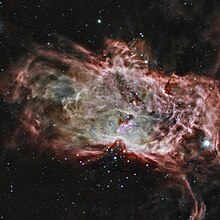提示 :此條目介紹的是獵戶座的火焰星雲,請勿將其與御夫座的
火焰之星星雲 混淆。
火焰星雲 ,給定的名稱是NGC 2024 和Sh2-277 ,是在獵戶座 的一個發射星雲 ,距離地球大約在900-1,500光年 。
獵戶腰帶 最東邊的參宿一 (獵戶座ζ),以高能的紫外光 照射到旁邊巨大的氫氣雲 ,將留駐在雲氣中的氫電離。當電子和電離氫重新結合時,會產生大量的輝光。位於星雲明亮部分前面,額外的暗氣體和塵埃是導致發光氣體中心出現暗網絡的原因。火焰星雲,包括著名的馬頭星雲 ,是獵戶座分子雲複合體 的一部分,這是一個恆星形成 區域。
火焰星雲的中心是由新形成的恆星組成的星團 [3] 星周盤 [4] 錢德拉X射線天文台 的 X射線 觀測[5] [6] [7] [8] [9]
來自
拉西拉天文台 ,以 B、V和R濾鏡三色合成的光學影像。
獵戶腰帶和火焰星雲區域的可見光廣視場圖。
錢卓X射線天文台所見的NGC 2024。
火焰星雲和馬頭星雲。
以Hα所見的火焰星雲和馬頭星雲
參考資料 [ 編輯 ]
^ Meyer, M. R.; et al. Star Formation in NGC 2023, NGC 2024, and Southern L1630. Reipurth, B. (編). Handbook of Star Forming Regions, Volume II: The Southern Sky ASP Monograph Publications 5 . 2008: 43. Bibcode:2008hsf1.book..662M ISBN 978-1-58381-670-7 ^ Is the Flame nebula easier to see than the Orion nebula? . stargazerslounge.com. [2018-03-24 ] . (原始內容存檔 於2023-03-03). ^ Haisch, K. E. Jr.; Lada, E. A.; Lada, C. J. A Near-Infrared L-Band Survey of the Young Embedded Cluster NGC 2024. Astronomical Journal. 2000, 120 (2): 1396–1409. Bibcode:2000AJ....120.1396H S2CID 18143699 arXiv:astro-ph/0006219 doi:10.1086/301521 ^ Haisch, K. E. Jr.; et al. A Mid-Infrared Study of the Young Stellar Population in the NGC 2024 Cluster . Astronomical Journal. 2001, 121 (3): 1512–1521. Bibcode:2001AJ....121.1512H S2CID 1645511 arXiv:astro-ph/0012482 doi:10.1086/319397 ^ Skinner, S.; Gagné, M.; Belzer, E. A Deep Chandra X-Ray Observation of the Embedded Young Cluster in NGC 2024. Astrophysical Journal. 2003, 598 (1): 375–391. Bibcode:2003ApJ...598..375S S2CID 18798394 arXiv:astro-ph/0306566 doi:10.1086/378085 ^ Broos, P. S.; et al. Identifying Young Stars in Massive Star-forming Regions for the MYStIX Project. Astrophysical Journal. 2013, 209 (2): 32. Bibcode:2013ApJS..209...32B S2CID 67827240 arXiv:1309.4500 doi:10.1088/0067-0049/209/2/32 ^ Kuhn, M. A.; Getman, K. V.; Feigelson, E. D. The Spatial Structure of Young Stellar Clusters. II. Total Young Stellar Populations. Astrophysical Journal. 2015, 802 (1): 60. Bibcode:2015ApJ...802...60K S2CID 119309858 arXiv:1501.05300 doi:10.1088/0004-637X/802/1/60 ^ Getman, K. V.; Feigelson, E. D.; Kuhn, M. A. Core-Halo Age Gradients and Star Formation in the Orion Nebula and NGC 2024 Young Stellar Clusters. Astrophysical Journal. 2014, 787 (2): 109. Bibcode:2014ApJ...787..109G S2CID 118503957 arXiv:1403.2742 doi:10.1088/0004-637X/787/2/109 ^ Nemiroff, R.; Bonnell, J. (編). Inside the Flame Nebula . Astronomy Picture of the Day . NASA . 10 May 2014 [February 14, 2015] .
外部連結 [ 編輯 ] NGC 2024 . SIMBAD . 斯特拉斯堡天文資料中心 . Nemiroff, R.; Bonnell, J. (編). The Flame Nebula in Infrared . Astronomy Picture of the Day . NASA . 13 July 1999. WikiSky 上關於The Flame Nebula的內容:DSS2 , SDSS , GALEX , IRAS , 氫α , X射線 , 天文照片 , 天圖 , 文章和圖片 天球赤道座標 :05h 41m 54s ,−01° 51′ 00″

 . doi:10.1086/301521.
. doi:10.1086/301521.
 . doi:10.1086/319397.
. doi:10.1086/319397.
 . doi:10.1086/378085.
. doi:10.1086/378085.
 . doi:10.1088/0067-0049/209/2/32.
. doi:10.1088/0067-0049/209/2/32.
 . doi:10.1088/0004-637X/802/1/60.
. doi:10.1088/0004-637X/802/1/60.
 . doi:10.1088/0004-637X/787/2/109.
. doi:10.1088/0004-637X/787/2/109.







